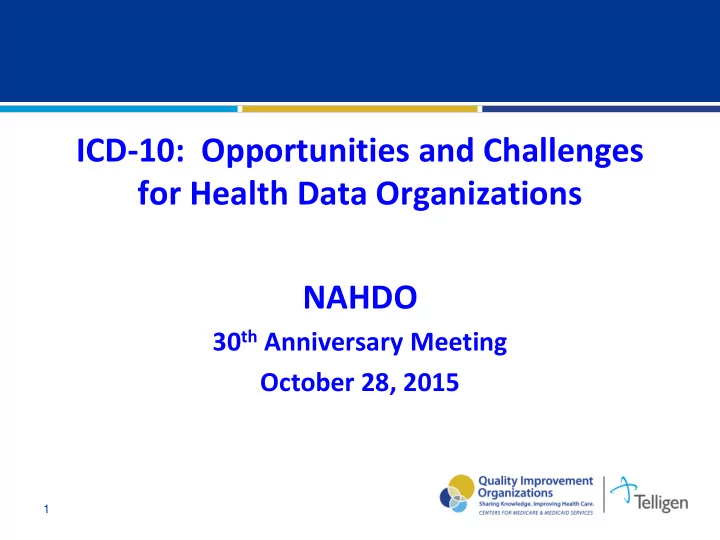

ICD-10: Opportunities and Challenges for Health Data Organizations NAHDO 30 th Anniversary Meeting October 28, 2015 1
Objectives Importance of understanding impact of ICD-10 on data analysis; lessons to be learned Hidden challenges and opportunities Details are important Working in collaboration with others to understand complexities 2
ICD-10 • Changes to reflect new knowledge and experiences • 30 years ago…… • Value of data and information to patients and families, providers, regulators, legislators, research, consumers, health plans, etc. 3
The World Did Not End 4
Changes Will Have an Impact • Remember Y2K? • What about 2004? 2011? – Data receipt or acceptance versus processing and utilization • Data details do make a difference – Infections – Mental Health – Chronic Renal Failure 5
ICD-10 Alignment • Align with the world and death records • Coders can now code actual conditions and procedures 6
ICD-10 Challenges for Analytics • More in-depth information • How to cross-walk effectively? Go from specific to general to trend? • Many analytic systems not ready • Assignment of Present on Admission (POA) codes and E-Codes; POA has exempt list for ICD-10 7
Medicare Learning Network ICD-9-CM Diagnoses Codes : Are 3 – 5 digits; ™ ™ The first digit is alpha (E or V) or numeric (alpha characters are not case sensitive); Digits 2 – 5 are numeric; and ™ ™ A decimal is used after the third character. ICD-10-CM Diagnosis Codes: Are 3 – 7 digits; ™ ™ Digit 1 is alpha; ™ Digit 2 is numeric; Digits 3 – 7 are alpha or numeric (alpha characters are not case sensitive); and ™ ™ A decimal is used after the third character. More extensive coding for example injuries, diabetes, substance abuse, post-op complications E-codes are optional – consult your state requirements and health plans . 8
Trending and Comparative Analysis • Knowing Data – Homework for all of us – How many codes processed by health plans and passed on? – Medicare Fee for Service – only Medicare data Medicare Advantage growing – 31% of Medicare beneficiaries Colorado – 37%; Iowa 14%; Illinois 21% Medicare Advantage data from hospitals in discharge data base and from commercial health plans in APCD o How many codes are captured and submitted to APCD from health plans? o Hospitals typically report all diagnostic codes to discharge data systems, but may be hitting maximum allowable to be reported 9
Expanding Number of Diagnoses and Procedure Codes Reported…..and Processed? • Are 25 diagnosis and 25 procedure codes sufficient? • Currently 25 diagnosis codes reported on all Medicare claims; below are the percent of Fee for Service claims with 25 filled diagnosis code fields: – Colorado 10%; Iowa 5%; Illinois 8% • Population Health Management and Management of Complex Care Patients – Policy Issues – With narrowed networks, are Medicare Advantage patients more complex, less complex, or the same? 10
Additional Information: 630-928-5820 Pat Merryweather pmerryweather@telligen.org 11
Recommend
More recommend